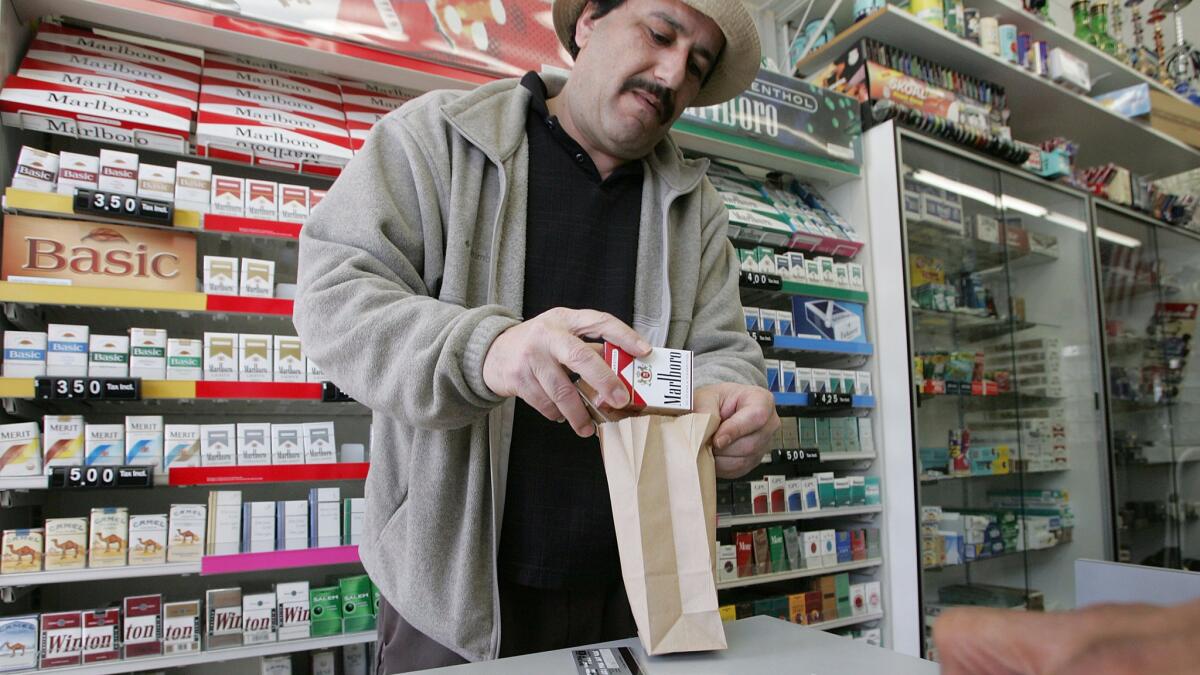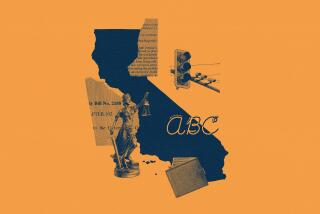If California’s 21-and-up smoking law is a success, other states may follow suit

California this year became the second state after Hawaii to raise its minimum smoking age to 21. When the law took effect in June, state public health officials declared it would “literally be a life-saving measure.”
But experts say it’s too soon to know whether the law will live up to such claims, and there are few studies from elsewhere pointing the way.
“We’re going to have to let the policy settle in,” said Dr. Stanton Glantz, a UC San Francisco professor who studies tobacco policies.
With many watching what happens in California, the state has become a national test case for a 21-and-up smoking law — one that could have major implications for dozens of places now considering similar legislation.
Needham, Mass., raised its smoking age to 21 in 2005, becoming the first U.S. city to do so.
In five years, smoking rates among Needham high schoolers fell by nearly half, according to a study released last year. And the adult smoking rate in the town is now 8%, compared with 18.1% statewide.
April Roeseler, head of the California public health department’s Tobacco Control Program, said she thinks the results could be similar here.
“If we can push that age up where fewer and fewer people start smoking as a teen, it’s likely that we will start to have some tobacco-free generations,” she said.
A big unknown, however, are e-cigarettes, which young people now tend to smoke more than regular cigarettes, she said.
Though California this year reclassified e-cigarettes as tobacco products and banned them in restaurants and bars, Roeseler said vaping devices are easier to hide than regular cigarettes and could prove harder to stop people from using.
Aayala Farrior, 19, said her classmates smoked e-cigarettes in the hallways of her high school in Oakland. They liked them because they tasted like candy, she said: “It’s a big part of it.”
To fully evaluate the new law, the state public health department will monitor both e-cigarette and cigarette smoking rates among youth and adults. Department director Dr. Karen Smith said she thinks the state is “well-positioned” to measure whether 21-and-up smoking laws have their intended effect.
Since the law took effect four months ago, the California Smokers’ Helpline hasn’t noticed an uptick in calls from people between the ages of 18 or 20 trying to quit, said clinical director Dr. Gary Tedeschi. However, Tedeschi said he expects a flood of calls if voters approve the cigarette tax increase on the November ballot.
At his liquor store in Oakland, Leonard Charles has turned away people under 21 trying to buy cigarettes, but he said he thinks they can still easily get them from their older friends.
“They’re hanging out and partying together, so they’ll just get someone else to buy,” he said.
Interested in the stories shaping California? Sign up for the free Essential California newsletter »
Others say they’re able to skirt the law by bumming cigarettes off other people or buying them online.
Still, experts say, that doesn’t necessarily mean the law isn’t working.
The biggest effect of a 21-and-up smoking law isn’t expected to be on 18- to 20-year-olds, but on 15- to 17-year-olds.
A 2015 Institute of Medicine study predicted that increasing the national minimum smoking age to 21 would cut smoking initiation among 15- to 17-year-olds by 25%, compared with 15% for 18- to 20-year-olds.
That’s because the law is believed to push cigarettes out of a 15-year-old’s social circle more than it does out of an 18-year-old’s.
“Most 15-year-olds know somebody who’s 18, but they don’t know many people who are 21,” Glantz said.
Experts say that although alcohol makes its way into the hands of high schoolers despite a minimum purchasing age of 21, there is much less drinking than if 18-year-olds could legally buy alcohol.
However, past efforts to better enforce smoking laws haven’t worked well in curbing youth smoking rates, Glantz said. He thinks that’s because the biggest driver of youth smoking is that young people want cigarettes, not that they can get their hands on them.
“The short answer is I don’t know,” he said, adding that it would take years before the effects of California’s law are apparent.
Bill Bunnell, who runs a convenience store in Fresno, said he hasn’t fielded many complaints from customers about the new law. He did, however, hear a 19-year-old man say he was moving to Oklahoma because he could no longer buy cigarettes.
California already has the second-lowest smoking rate in the country. The rate among 18- to 20-year-olds is even lower than the state average — 10% for men and 4% for women, Roeseler said.
But the law is aimed more at preventing people from taking up the habit than at current smokers, she said. The average Californian first tries a cigarette at age 14, and this law is expected to increase that age, she said.
Kids who start smoking before age 15 are 10 times more likely to become addicted than someone who waits until age 21, said Laurence Steinberg, a psychology professor at Temple University who studies adolescent development.
That’s because younger brains are more sensitive to rewards and more malleable, while the parts of the brain central to impulse control and long-term thinking are still developing, he said.
“A 14-year-old who’s handed a cigarette at a party is not thinking what if she’s going to get emphysema when she’s 50,” Steinberg said.
Some big cities, including Chicago and New York, have recently adopted laws requiring that people be at least 21 to buy tobacco. (The national minimum smoking age is set at 18 and can be increased only by local governments.)
Advocates in Oregon, Washington and New Jersey are pushing for similar legislation.
State Sen. Ed Hernandez (D-West Covina), who wrote the tobacco legislation, said he hopes California’s change influences even more to also move in that direction.
“How California goes, the rest of the country goes,” he said.
soumya.karlamangla@latimes.com
Twitter: @skarlamangla
ALSO
Thousands gather in downtown L.A. for CicLAvia bike festival
2 men arrested in connection with West Adams shooting that left 3 dead and 12 wounded
More to Read
Start your day right
Sign up for Essential California for news, features and recommendations from the L.A. Times and beyond in your inbox six days a week.
You may occasionally receive promotional content from the Los Angeles Times.







